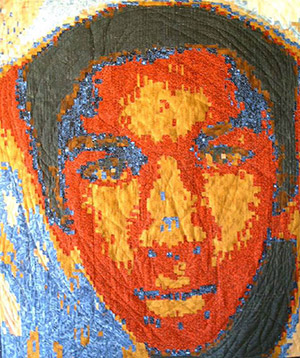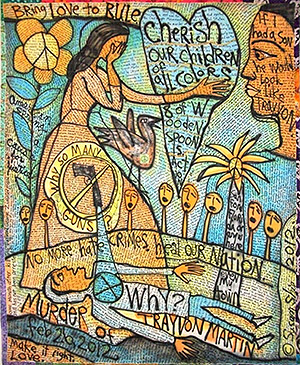“AMERICAN SPRING, A CAUSE FOR JUSTICE,” 23 story quilts that narrate the Trayvon Martin shooting in  Florida, will be on display at Pomona College, beginning Feb. 23. The quilts come from the Fiber Artists of Hope Network and reveal reactions to Martin’s death in 2012 and hopes for a better America.
Florida, will be on display at Pomona College, beginning Feb. 23. The quilts come from the Fiber Artists of Hope Network and reveal reactions to Martin’s death in 2012 and hopes for a better America.
The exhibition will be open Feb. 23 to March 8, 2015, at the Pomona College Bridges Auditorium (450 N. College Way, Claremont) and is free to the public. An opening reception will be held on Thursday, Feb. 26, with lectures at 6 p.m. and the reception at 7 p.m.
The exhibition is open on Monday–Wednesday and Friday-Saturday, from 10 a.m. to 4 p.m. On Thursdays, the exhibition will be open 1-7 p.m. in connection with the Pomona College Museum of Art’s Art After Hours program. On Sundays, the exhibit will be open 12-3 p.m.
Story quilting expands on traditional textile-arts techniques to record, in fabric, events of personal or historical significance. Through the accessibility of their colors, patterns and symbols, the quilts of ”American Spring: A Cause for Justice” relate narratives that enable conversations about sensitive topics from our national history, furthering the discussion of racial reconciliation in America. This exhibition is curated by Theresa Shellcroft and is organized by the Fiber Artists of Hope in Victorville, Calif.
The quilts have been exhibited to the Congressional Black Caucus, in Atlanta, Baltimore, Little Rock, Los Angeles, Marion (IN), Philadelphia, Victorville and Washington, DC, among other locations.
Associate Dean Jan Collins-Eaglin saw the quilts at the African American Quilting Guild meeting in Los Angeles last year. “Each quilt tells a story,” she says. “They’re very evocative and interpretations of what happened. I really wanted our students to be able to see them. Then there were the shootings of Michael Brown in Ferguson and Eric Garner in New York.
“Through art, we can heal, and this has that power. We can begin to talk about what these artists hope for, and what we hope for. There are so many little details in the quilts, and as you look at them more closely, you begin to talk about them.”
—Cynthia Peters
